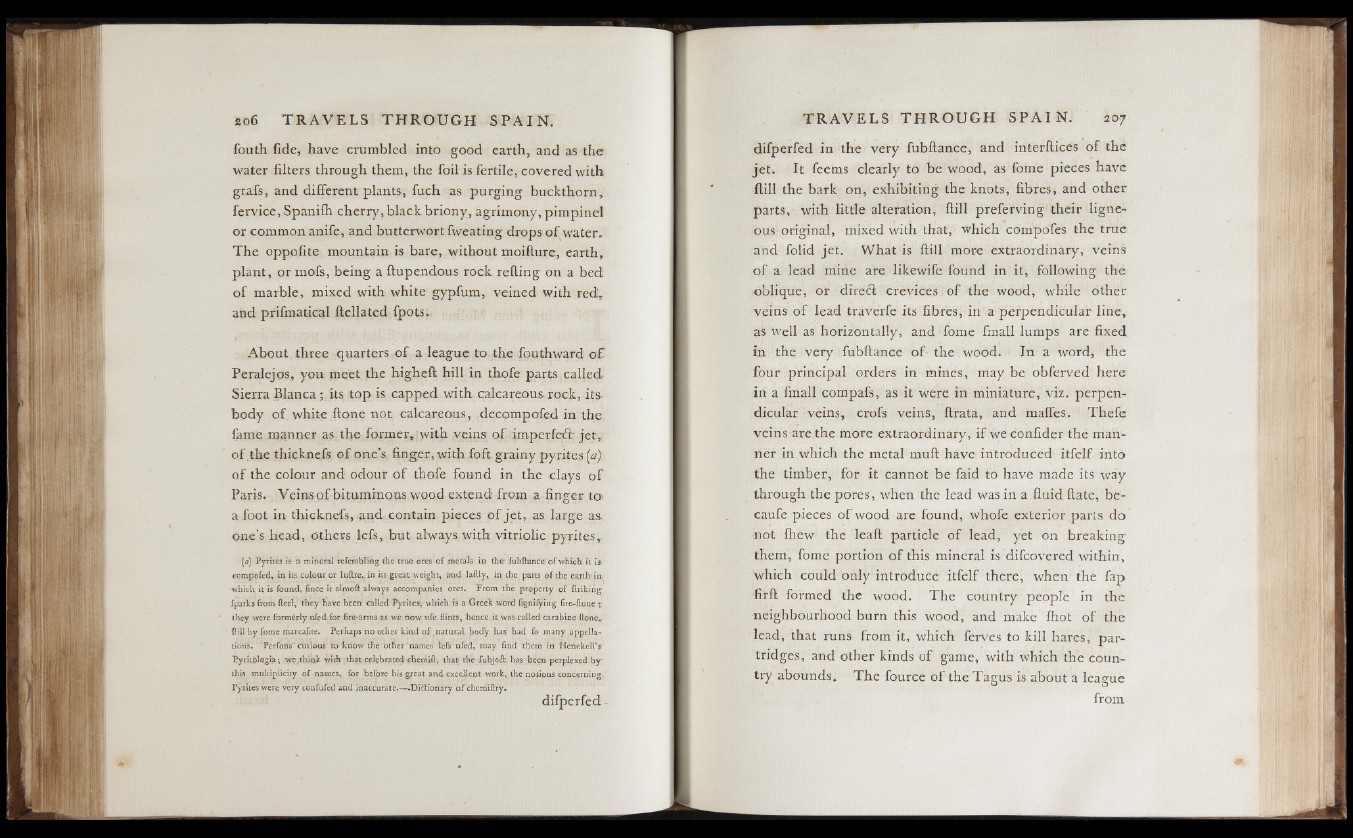
fouth fide, have crumbled into good earth, and as the
water filters through them, the foil is fertile, covered with
grafs, and different plants, fuch as purging buckthorn,
fervice, Spaniih cherry, black briony, agrimony, pimpinel
or common anife, and butterwortfweating drops o f water.
The oppofite mountain is bare, without moifture, earth,
plant, or mofs, being a ftupendous rock refling on a bed
of marble, mixed with white gypfum, veined with red,
and prifmatical itellated fpots:
About three quarters of a league to the fouthward o f
Peralejos, you meet the higheft hill in thofe parts called
Sierra Blanca; its top is capped with calcareous rock, its-
body of white ftone not calcareous, decompofed in the
iame manner as the former, with veins o f imperfect’ jet,
of the thicknefs of one’s, finger, with foft grainy pyrites (a)
of the colour and odour of thofe found in the clays o f
Paris. Veinsof bituminous wood extend from a finger to
a foot in thicknefs, and contain pieces of jet, as large as.
one’s head, others lefs, but always with vitriolic pyrites,
(¿7) Pyrites is- a- mineral refetnbli-ng the true ores o f naetals in the- fubftance o f which it is-
compofed, in its..colour or luftre„in its great weight, and laflly, in the parts ©fthe earth'ia
which it is found, fince it almofi always accompanies ores. From the property o f finking,
fparks from fteel, they have been- called Pyrites', which is a Greek word fignifyi’ug fire-ftone ;
they were formerly ufed. for fire-arms as we now ufe flints, hence it was.called carabine floner
flill b y fome marcafite. Perhaps no other kind o f .natural body has had (b many appellations.
Perfohs'curious to know the ocher'names lefs ufed, may find them in HenekellV
Pyritblogia; 'we,think with that celebrated chemift, that? the fubjeft has been perplexed by
this multiplicity o f names, for before his great and excellent work, the notions concerning.
Pyrites were very confufed and inaccurate.-— Dlffronary o f chemifrry.
diiperfed
difperfed in the very fubftance, and interftices of the
jet. It feems clearly to be wood, as fome pieces have
flill the bark on, exhibiting the knots, fibres, and other
parts, with little alteration, ftill preferving their ligneous
original, mixed with that, which compofes the true
and folid jet. What is ftill more extraordinary, veins
of a lead mine are likewife found in it, following the
oblique, or direil crevices of the wood, while other
veins of lead traverfe its fibres, in a perpendicular line,
as well as horizontally, and fome fmall lumps are fixed
in the very fubftance o f the .wood. In a word, the
four principal orders in mines, may be obferved here
in a fmall compafs, as it were in miniature, viz. perpendicular
veins, crofs veins, ftrata, and mafles. Thefe
veins are the more extraordinary, if weconiider the manner
in which the metal muft have introduced itfelf into
the timber, for it cannot be faid to have made its way
through the pores, when the lead was in a fluid ftate, be-
caufe pieces of wood are found, whofe exterior parts do
not ihew the leaft particle of lead, yet on breaking
them, fome portion of this mineral is difcovered within,
which could only introduce itfelf there, when the fap
firft formed the wood. The country people in the
neighbourhood burn this wood, and make ihot o f the
lead* that runs from it, which ferves to kill hares, partridges,
and other kinds of game, with which the country
abounds. The fource of the Tagus is about a league
from